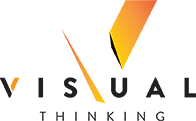
VISUAL INVENTIVENESS VERSUS COOKIE-CUTTER DEVICES IN SHARED WORK ENVIRONMENTS
Visuality is a language. Its purpose is to express our current understanding of the company’s operational system and imbed it into the living landscape of work—through visual devices and visual mini-systems. Because these devices and systems hold our operational intelligence, visuality lets us see how we think and what works and what needs to improve. A high-functioning visual workplace can have a sizeable impact on your KPIs: often a 15% to 30% increase in productivity. This is reason enough to pursue the visual workplace.
But there is another impact that in many ways is more elusive and more valuable—cultural alignment. Because visuality is a language, we must learn to speak it, developing a handsome vocabulary of visual solutions, based on sound visual principles. And as with any lingo, once we get the hang of it, we move more smoothly through our world—we become more connected, more confident, more fluid, and more effective. In the workplace, this results in a remarkable cultural progression for the workforce, for team and, perhaps most powerfully, for the individual. I refer to this pivotal role of the individual in visuality as “I-driven”—the power of the individual will and its contribution to the corporate intent
And this brings us directly to a common challenge in implementing any team-based change: How to handle a shared work space when it is the target of improvement—a shared machine, a shared bench, a shared desk, shared tools. We know we need to respect the individual, and yet these particular individuals are also expected to find a way to amicably share their corner of the world–even as they seek to control it. A territorial imperative can often take over. Even though the company owns the actual bench, machine, tool set, it still feels like mine; I may share it with other shifts but I use it with such regularity and over so many years, it still feels like mine.
In my early years as an implementer, I was often challenged by this as well. How can I get people to move forward with the physical change that visuality requires when the emotional/ownership issue is so loud, so dominant? How do I cultivate improvement ownership when the boundaries are so loose? Here’s what that challenge sounds like from Jeff’s viewpoint. I work on second shift and have use of my bench for eight hours, five times a week. I know what I want to do to improve it—I know exactly what I want to do. But I can’t because Maryanne uses the same bench when she comes in for the graveyard. If I “improve” anything, there is a pretty good chance she won’t like it (even though she seems like a nice person); or she may like a part of it but not all of it—and I’ll have to wait two whole shifts before I find out. And what about George who works the day shift. He’s bound to want a say in this as well. And he’s left handed….
This is fraught issue and one that often causes management to prize uniformity over inventiveness as the only practical way of handling what—on the face of it—looks like a no-win scenario.
In fact, there is a better way, one I developed in the face of the seemingly impossible contradiction of a shared work environment—and a deep and an abiding allegiance to I-driven improvement and the power of the individual to create high impact/low cost innovation that inspire and solve. That better way not only skirts around cookie-cutter solutions (dilution by uniformity), it purposefully harnesses the inventiveness of the individual—all individuals.
I call this the prototype solution—developing models of visual functionality that balance what change needs to happen with how to get that done. The result? Solutions that are superior, even dazzling—and the growth of the I in both competency and confidence. Join me next week here at the The Visual Thinker, and I’ll share it with you.
Taichi Ohno—co-architect with Shigeo Shingo of the Toyota Production System—liked to say: “People don’t come to Toyota to work. They come to think.” Let’s take every opportunity to build the power of people thinking for the business benefit for our organizations and for the sheer delight.



